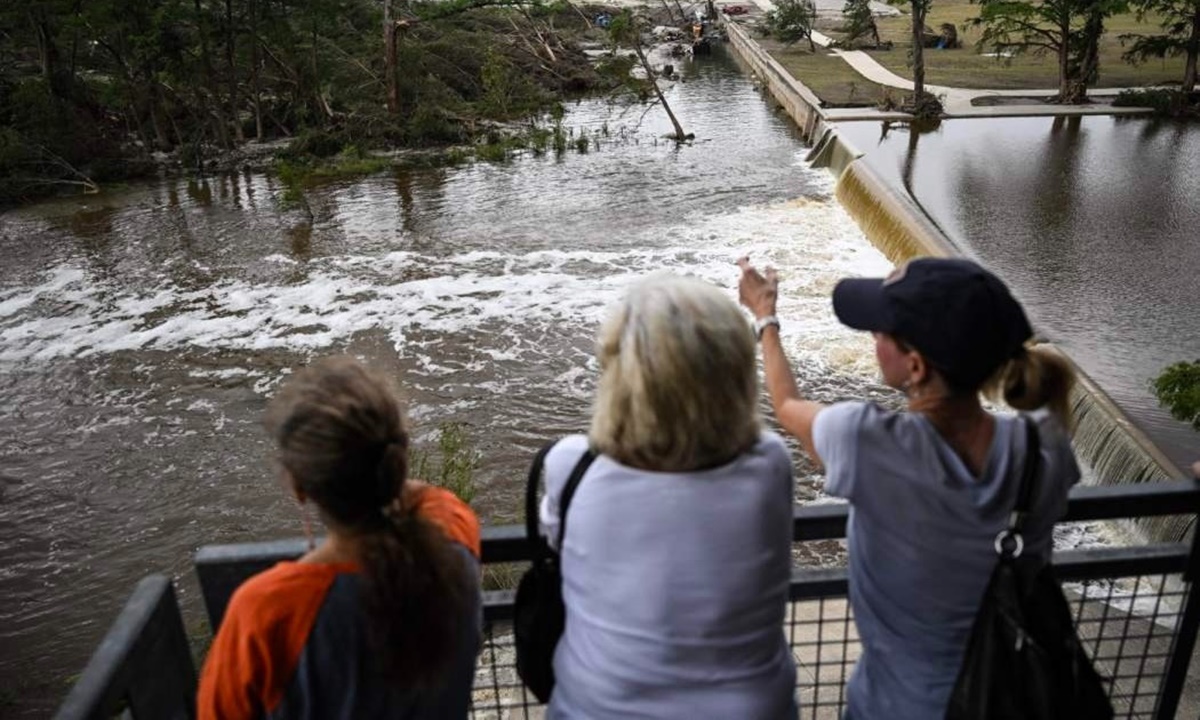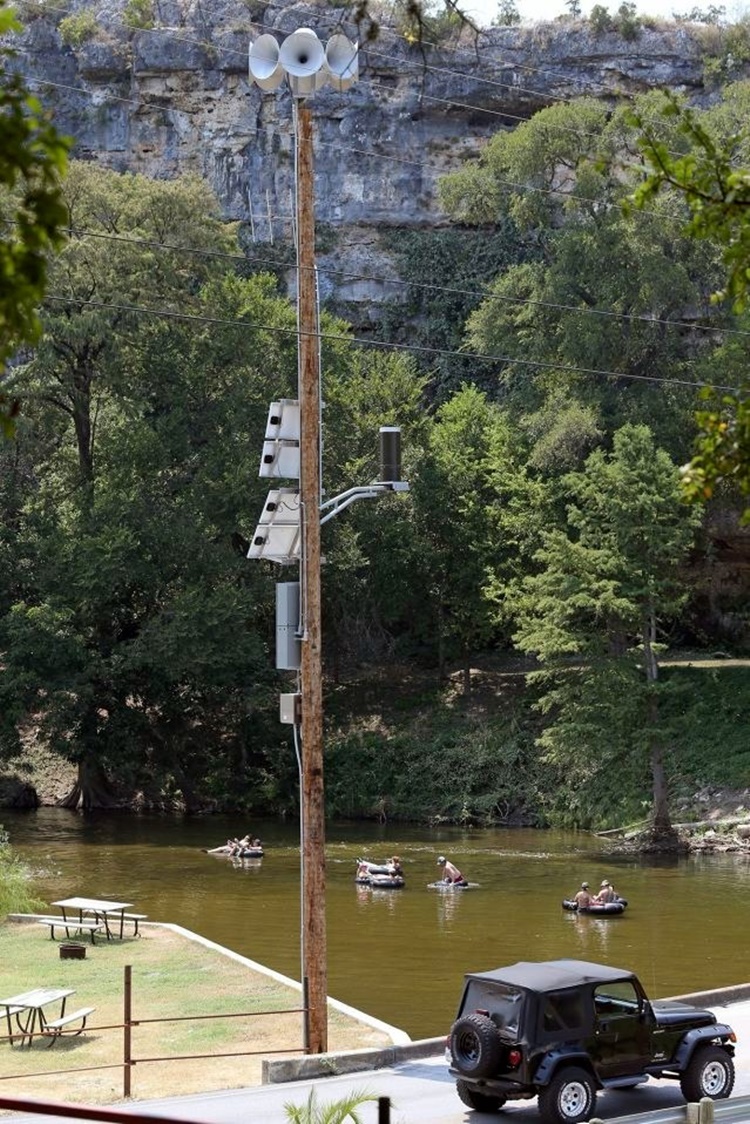Eight years ago, after a flood in the Texas Hill Country, Kerr County officials debated whether to upgrade the flood warning system along the Guadalupe River.
For years, Kerr County officials ensured the safety of summer camps packed with students along the Guadalupe River using a very manual method. When the river began to rise, upstream camp directors would warn downstream camps about the impending flood.
 |
The Guadalupe River in Kerrville, Texas, on 6/7. Photo: AFP |
The Guadalupe River in Kerrville, Texas, on 6/7. Photo: AFP
But they worried that a human-dependent flood warning mechanism was insufficient and considered installing sirens, river gauges, and other modern communication devices.
According to the minutes of a 2017 Kerr County Commissioners Court meeting, the local government discussed that even with additional water level sensors along the Guadalupe River, they still needed an effective way to warn residents if the water rose too quickly.
"We can monitor the water level as much as we want, but if we can't get that information to people in a timely manner, the whole effort is useless," said Tom Moser, then a Kerr County commissioner.
"With the hilly terrain, mobile coverage in some areas here isn't very good," he said, adding that installing a series of sirens could provide enough time for people in the most vulnerable areas to evacuate.
But authorities ultimately didn't make many changes. When catastrophic floodwaters swept through Kerr County last week, they still had no sirens or early flood monitoring equipment. Instead, only belated warning messages reached some residents.
The Guadalupe River basin is one of the most dangerous areas in the US for flash floods. If a flash flood hits, residents near the Guadalupe River have very little time to reach higher ground, especially if it arrives late at night while people are sleeping.
Avantika Gori, a Rice University professor leading a federally funded project to improve flood resilience in rural Texas counties, said flood warning systems are often a simple network of rain gauges or river and stream gauges. These are activated when rainfall or floodwaters exceed a certain level.
Information from these devices is then used to warn communities at risk of flooding via text messages, which are ineffective in areas with spotty mobile service, through television and radio announcements, or sometimes through sirens.
According to Gori, more complex systems or models used by the National Weather Service can also be applied to flood warnings. In 2015, the city of Wimberley, in Hays County, Texas, installed an improved monitoring system with mobile phone towers that are still used to send alerts to all subscribers in the area.
Former council member Moser visited Wimberley after the area's new system was implemented. From there, he began pushing efforts to build a new flood warning model in Kerr County. However, this project was never implemented, mainly due to budget concerns.
"It just faded away," he said.
A council member at the time, H. A. "Buster" Baldwin, voted against the $50,000 engineering study project on the grounds that "sirens and things like that, they're a bit too extravagant for Kerr County".
Moser, who retired in 2021, said it's difficult to assess whether a flood warning system would have prevented the Kerr tragedy in the 4/7 flash flood. However, he believes it could still have brought some benefits.
"I think it would have helped a lot of people," he said.
The flash flood has so far killed 82 people, including at least 28 children, with many still missing. Moser believes this should be seen as a wake-up call.
"I think many places in America should look at what happened in Kerr County and consider what they can do to fix it," he said. "I believe there will be changes from this tragedy. This should be a lesson learned".
The moment Texas floods submerged a river runway in the Kingsland neighborhood, Blanco County, Texas, on 4/7. Video: Facebook/Meteorologist Noah Bergren
City officials on 6/7 did not mention the previous discussions about the flood warning system.
Dalton Rice, Kerrville's city manager, sidestepped questions about the effectiveness of the emergency notifications, telling reporters at a press conference that now is "not the time to speculate".
"There will be a full review of the incident to help us ensure we are focused on preparing for the future," he said.
According to Professor Gori, the decision not to install a warning system earlier in many Texas counties was mainly due to cost.
"If the county had a flood warning system, they could have been much better prepared, but most rural areas in Texas simply don't have the funds to implement such systems themselves," she noted.
Gori added that some simpler systems, such as using river level or rainfall sensors, may still not provide enough time for people to evacuate, due to the rapid rise of water in Kerr.
"Also, we lack a lot of data on rural counties, so it's almost impossible to identify areas prone to flooding," she said.
Texas is facing a backlog of flood management projects worth about $54 billion. The Texas Water Development Board has announced a flood control plan, which calls on lawmakers to allocate more funding to invest in life-saving infrastructure.
 |
A warning siren pole on the Guadalupe River in Comal County, Texas, in 2015. Photo: AP |
A warning siren pole on the Guadalupe River in Comal County, Texas, in 2015. Photo: AP
However, to date, the government has only allocated about $669 million, a very small fraction of the amount needed for flood response projects, through the state's Flood Infrastructure Fund.
Kerr County, in previous discussions about the warning system, along with other members of the Upper Guadalupe River Authority, had planned to apply for financial assistance through the infrastructure fund. However, they abandoned the idea after learning that the fund only provides about 5% of the money needed for the project.
During last week's floods, despite text message alerts warning of rapidly rising water levels, some residents were complacent because this was not unusual in the area.
Sujey Martin, a resident who has lived in Kerrville for the past 15 years, said she was awakened by an emergency alert on her phone around 2 a.m. on 4/7. She just glanced at it and went back to sleep.
"Things have never been this bad so I didn't think too much about the warning message," she said.
It wasn't until around 5 a.m. that she really felt worried when she saw her house lose power and started reading on Facebook about flooding and evacuations in some places just a few blocks from her home.
"It was raining very hard then," Martin recalled.
Louis Kocurek, 65, who lives in Center Point, about 16 km southeast of Kerrville, said he never received any text message warnings from the authorities about the flood. He had signed up for a private emergency alert service called CodeRED, but by the time the message from them arrived, his house had lost power. According to Kocurek, by then, he had known about the situation for at least three hours because his son-in-law had warned him around 6:30 a.m.
He checked the water level of the creek near his house and decided to stay, even though at one point the creek rose about 4.5 m in just 15 minutes. Kocurek's house is higher than some of his neighbors'.
He said the CodeRED alert arrived at 10:07 a.m. "By then the roads were cut off, there was no way out," he said.
In the end, his house was not flooded.
Linda Clanton, a retired teacher living on the outskirts of Kerrville, said she didn't know how bad the flooding was until her sister called to wake her up at 8:30 a.m. on 4/7. She wasn't sure how useful sirens would be in warning people about the rushing water.
The rapid rise of floodwaters in Texas on 4/7. Video: X/StormHQ
"We live scattered throughout these wooded hills," she said. "If a siren goes off in town, no one outside of town will hear it. You have to install sirens everywhere, which costs a lot of money and is prone to failure."
The dangers haven't stopped.
Around 3 p.m. on 6/7, another emergency alert was sent to residents along the Guadalupe River about the "very high risk of flooding from the river". The announcement urged people to move to higher ground.
Vu Hoang (According to AFP, Reuters, WSJ)












